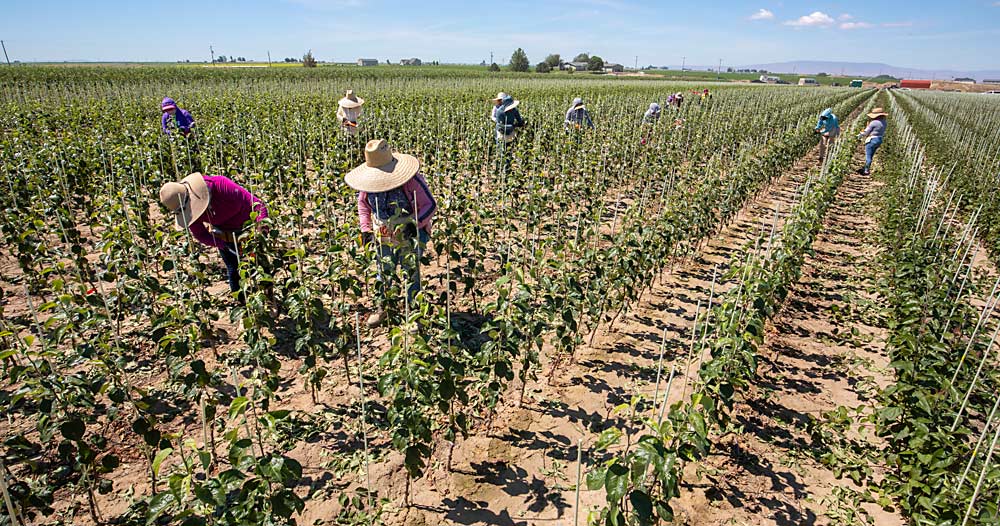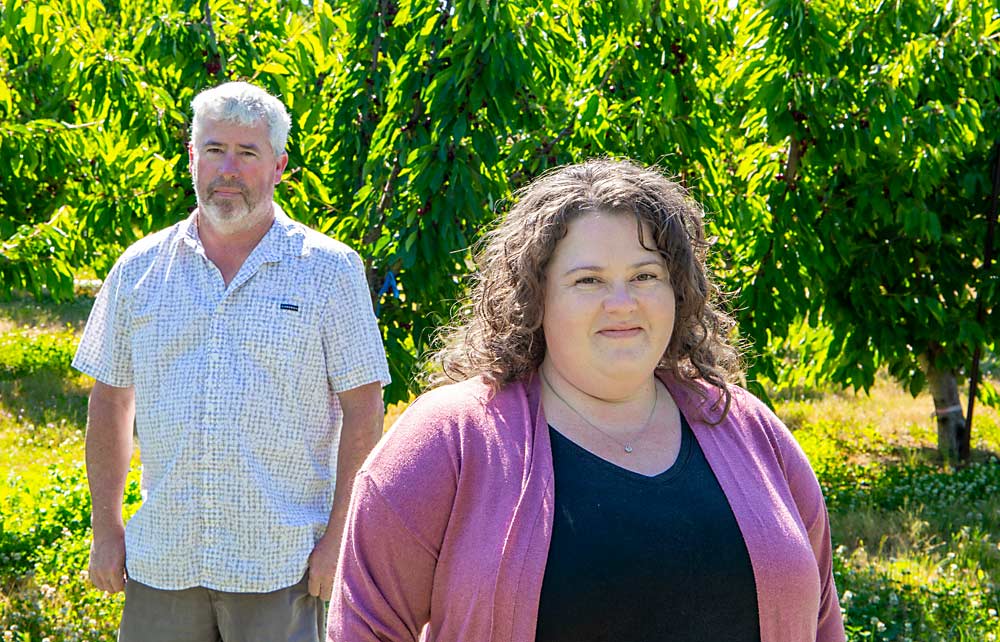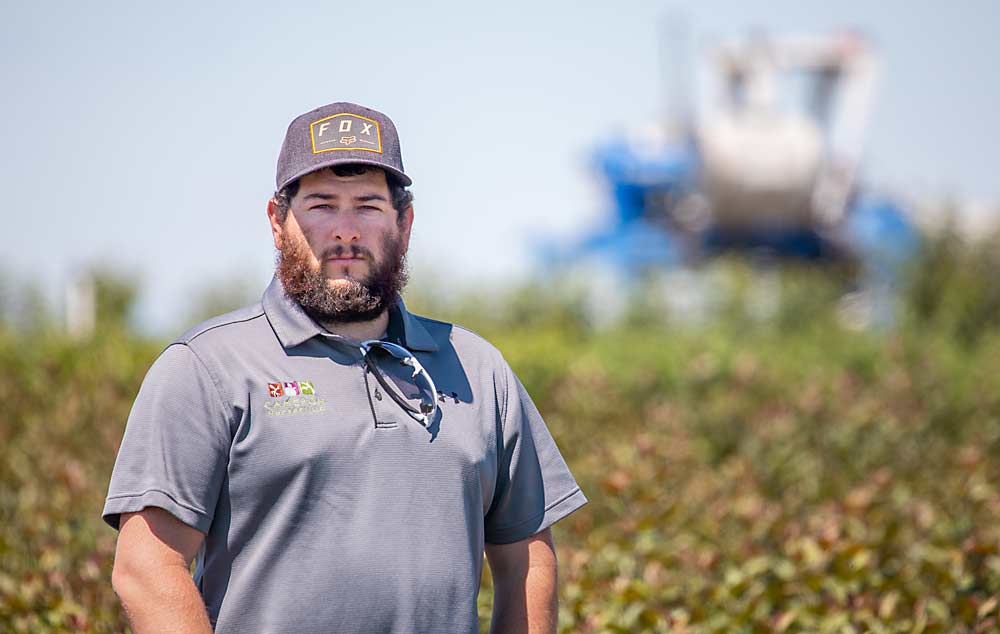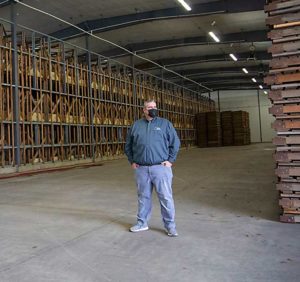
Washington’s apple growers just aren’t ordering trees like they used to.
That puts the nursery producers who supply the industry in the difficult position of downsizing their businesses to weather the downturn.
“We’re cutting down our size, as other nurseries seem to be doing as well,” said Todd Cameron, owner of Cameron Nursery. ‘To stay in the black, we’ve got to pull back.”
Cameron and his daughter, Allison Schrader, invited the International Fruit Tree Association to visit their nursery in Eltopia in July to talk about how the uncertainty in the apple market is affecting the nursery business and their family.
“We’ve gone from selling lots of trees before they are even budded to lots of customers who want to buy trees at the last minute because they don’t know what to plant,” Cameron said.
That led Cameron Nursery, and others, to produce trees on speculation, as many nurseries told Good Fruit Grower last year. That may have worked in the past, when growers had far fewer rootstock and variety combinations to choose from, but now, “trying to guess what someone might need is extremely dangerous,” said Dale Goldy, owner of Gold Crown Nursery in Quincy. “If you have a tree need, we can fill it for you. But we can’t put roots in the ground hoping somebody is going to want a finished tree.”
With ever-increasing costs and continued uncertainty, speculation is not sustainable, Cameron and Goldy said.
“Each tree you burn is the most expensive tree you ever made,” Cameron said. “So, we’re only going to plant what’s sold, we’re only going to bud what’s sold, and there’s not going to be as many trees available.”

Costs up and demand down
It’s not surprising that the Washington apple industry needed a pause in planting to reevaluate its direction after the “big boom in planting in the late 20-teens,” said Jim Adams of Willow Drive Nursery. But it happened amid many other challenges that no one could predict: A pandemic. Inflation. Export challenges. Political uncertainty.
“(The industry) is going to see our way through it in the next couple years, but there’s just too much turmoil in the world right now,” Adams said. And as for Willow Drive itself: “We’re just trying to be as conservative as possible and not make any big moves.”
The rising cost of fuel and fertilizer affects nurseries too, but labor poses the biggest cost to producing quality trees, Adams said. “We do our best to keep our costs down and try to reimagine our labor needs, but it’s called a nursery for a reason — there’s a lot of labor input.”
Good Fruit Grower reached out to several other Washington nurseries, who declined to comment for this story. But a few acknowledged similar challenges.
At Cameron Nursery, Schrader acknowledged that pulling back capacity to rein in costs now means there could be a tree shortage when the industry starts ordering more trees again in the future.
This year, they planted about 50 percent less than last year, which was also about 50 percent down from the year before, she said. “The nursery guys, we talk to each other, and it sounds like the others are doing the same thing,” she said.
Part of the challenge is that rootstock-scion pairings have become far more complicated. It used to be that a large customer would contract 100,000 M.9-337 rootstocks and then pick the variety. Now, growers must decide on a variety, then select the right rootstock for that cultivar and the site, which requires more preplanning, Cameron said.
Goldy said he’s sourcing rootstocks this year for finished trees in 2025 — that’s how far in advance growers need to plan. And with more information continuing to emerge about newer Geneva rootstocks, it’s even harder for nurseries to predict which rootstocks to invest in.
Some previously popular combinations can turn out to be predisposed to problems, such as the nutrient imbalance found in Honeycrisp on G.41.
For years, nurseries couldn’t produce enough G.41 to meet the demand, Goldy said; now they can, but growers want to put Honeycrisp on G.969 or G.890.
Cameron Nursery will no longer make that Honeycrisp on G.41 combination. “We’re finding this out after we’ve already made a bunch,” Schrader said. “We had a lot in the ground, because it’s supposed to be a rock star, and now we find out that it’s not.” It is their No. 1 rootstock, and they are taking out half.
But downsizing the family business, which Cameron’s parents started in 1980, means that the third generation — business manager Schrader and her brother, Eric, the production manager — must seek other employment.

“My brother and I had been here with the idea of taking this over. It’s a very difficult thing to accept,” she said. “But I really respect my dad for making that decision and showing our customers that we are doing this proactively to be fiscally responsible. The worst thing would be to run until the bottom runs out.”
The nursery industry has certainly weathered ups and downs in the apple industry before, Cameron said. He’s concerned the next few years will see more apple orchards coming out than going in, as growers grapple with rising costs of production, arduous regulations and consolidation. And this time, it’s more than his own finances at stake.
“The difference is I’m not 30 anymore. I have grandkids, and I need my kids to have a stable income,” he said. “If we only grow 100,000 or 200,000 trees a year, I will figure out how to do that, but it will support a much smaller company.”
Schrader started as a manager at the Agri-Service dealership in Pasco in July. She said the nursery is retaining key staff, including salesman Jacob Hafer and foreman Ruben Ramos, but shrinking the middle management and seasonal staff.
Growers need to understand that costs of production are also increasing for nurseries — 5 to 10 percent. “Prices are going to go up, or we can’t make trees,” Cameron said.
In the past, if growers changed their minds after contracting trees, the nursery would be able to resell those trees because the demand was there. Now, he said, “that’s going to be over. We can’t afford to be the nice guys.”
Goldy said his message to growers is that advance planning holds the key to the future of tree supply.
“The fundamental change is that I can do anything you need, but I can’t do anything I am going to have to burn,” he said. “Advance communication is key to helping nurseries plan.” •
—by Kate Prengaman







Leave A Comment